Loving Lisbon
January 25, 2009 - The Boston Globe - Travel
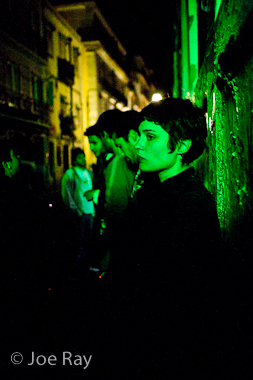
LISBON - I knew for years before I arrived that I would fall in love with this city. What I hadn’t counted on was falling for the sardine lady.
The love story began in 1994 with “Lisbon Story,” German director Wim Wenders’s ode to the city, its gentle people, trademark fado music, cobblestone streets and tiled facades, and the tiny, heartbreakingly cute yellow trolleys that make their way up and down its seven hills. Leaving modern Europe and the languages he knows behind, the film’s protagonist enters the city with his heart and his senses wide open.
I vow to do the same and discover people who are Portugal’s living soul, conscious of the need to preserve their heritage and constantly redefining themselves using a sage mix of beauty and sadness, with both the past and hopes for the future as guides.
“There are people who pass through life,” says Regina Ferreira, who runs the Conserveira de Lisboa (The Lisbon Cannery), “and then there are people who have life pass through them.” Lisbon is gifted with a bumper crop of the latter.
I meet Ferreira, whom the French might gently refer to as une dame d’un certain âge, without looking for her. Guided only by good fortune, I wander in front of her store, a Lisbon landmark since 1930, tucked into a corner of the grid-like center of town known as the Baixa. Sitting on a wooden bench beneath a wall of boxes of sardine tins, I realize I’m in trouble when we compare the goose bumps on our arms talking about singer Jacques Brel.
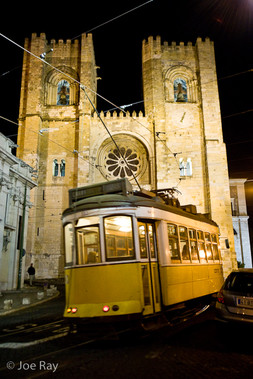 Above, One of Lisbon’s signature yellow trolleys (also known as eléctricos) in front of the city’s cathedral, known as the Sé de Lisboa. Photos: Joe Ray for The Boston Globe
Above, One of Lisbon’s signature yellow trolleys (also known as eléctricos) in front of the city’s cathedral, known as the Sé de Lisboa. Photos: Joe Ray for The Boston GlobeFerreira explains how for decades her father and her husband ran the company, creating products that eventually outlasted the long reign of dictator António de Oliveira Salazar (1932-68). She left her job with the state and took over the cannery after the death of her husband in 2004.
“Working can be like mental prostitution,” she says, comparing her old job to her new one, “but food is culture.”
The conversation eventually transcends sardines, and it’s evident that though her business is successful, she is here because the cannery is an ode to her country, and working here is a way to continue saying “I love you” to her husband.
As she speaks, Ferreira is so endearingly caught up in ideas of her country, her family, and the past, she leans so far forward her head is nearly horizontal.
I worry aloud that, like the mom-and-pop hat and glove shops that still dot her city’s streets, a place this wonderfully outdated might eventually succumb to time and be replaced by one of the chain stores that are slowly multiplying around town. “We’ve gotten past problems with factories, with freezing, with the arrival of big box stores. We made it,” she assures me. “We’ll be here.”
Change has come, but it takes time to understand how a nation this isolated at the end of the Iberian Peninsula survived being drawn into the 21st century.
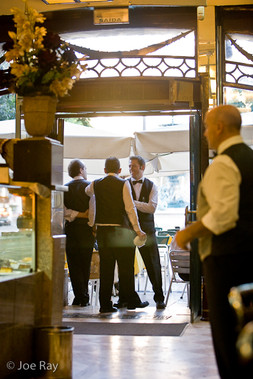 Below, a view from inside a café, in Lisbon’s central Baixa district. Photos: Joe Ray for The Boston Globe
Below, a view from inside a café, in Lisbon’s central Baixa district. Photos: Joe Ray for The Boston Globe“We had a rough regime up until 1974. Between ‘74 and the mid-‘80s, people . . . survive,” says José Caetano, who got together with Italian chef Augusto Gemelli to open the high-end Gemelli restaurant in 2007.
“My parents - our parents - were in a prison. It was impossible to get out. If you did, you took a bag and the clothes on your back and you left,” Caetano says. “Now, Portugal is changing in terms of maturity. People who are 30 and 40 are more interested in food, cinema, art, theater, and expositions. These are the people who are pushing the country.”
Here, something clicks. Portugal’s political and geographic isolation created an island-like buffer that gave its people time to evaluate and adopt or decline an outside influence. While Paris paved over miles of its cobblestones, Lisbon’s streets and sidewalks are beautifully coated with them. Here, people are both set in their habits and open to doses of outside influence.
“We’re strangely motivated by our personal culture. We like sardines and tuna and fado,” says Caetano, “Young people now like these things because they are Portuguese.
“I don’t think too many Starbucks will come,” he says, referring to the Seattle company’s lone Portuguese outpost, in a shopping center several miles west of the capital. “If you talk with a thousand people, they’ll all say they prefer Portuguese cafes. We like to get our coffee in the morning at the cafes near our homes. I send my son to pick up breakfast, and I’ll go down and pay later.”
Many here are realizing that there are things worth preserving. The wood-lined yellow trolleys - this city’s leisurely icons - still clink their way across five routes in town. Though the trolleys are hopelessly outdated money vacuums, locals habitually shun the metro and bus systems for a ride on their eléctrico.
“Four years ago, my feeling was that with globalization, we were all starting to be alike, to dress alike, to use the same products,” says Catarina Portas, a former journalist who opened A Vida Portuguesa, a boutique that specializes in nostalgic and enduring Portuguese products. “It was evident that we’d see a resurgence of the local.”
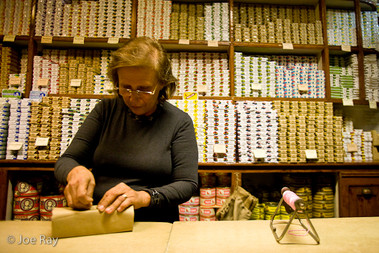 Inside the Conserveira de Lisboa - The Lisbon Cannery , owner Regina Ferreira prepares a package for a customer. “There are people who pass through life,†says Ferreira, “and then there are people who have life pass through them.†Lisbon is gifted with a bumper crop of the latter. Photos: Joe Ray for The Boston Globe
Inside the Conserveira de Lisboa - The Lisbon Cannery , owner Regina Ferreira prepares a package for a customer. “There are people who pass through life,†says Ferreira, “and then there are people who have life pass through them.†Lisbon is gifted with a bumper crop of the latter. Photos: Joe Ray for The Boston GlobeThe store is a shrine to the past, but cleverly in tune with the present. It exalts everything from Ferreira’s sardines to Coração metal polish - complete with the original 1928 logo of a heart pierced by an arrow - to tiny shrines to St. Anthony, the patron saint of good marriages and the finder of lost objects.
I watch a group of women in their 60s walk through the shop, stopping in front of almost every item, each clearly associated with a memory. Moments later, a twentysomething guy grabs a tube of Couto brand toothpaste and heads to the cash register as if he’s never heard of multinationals like Crest or Colgate.
“The younger generation has no idea what it was like to live in the Salazar times,” says Portas. “It influences us much more than we are conscious of, but these products help us figure out who we are.”
Over dinner with friends of friends (who, in typical local fashion, immediately become my friends), this quest for the Portuguese to understand who they are becomes evident when it comes to expressing themselves; that pierced heart is often worn on a sleeve.
“I think we became explorers because there’s nowhere to go,” says Pedro Matos, a United Nations consultant and founding member of the local citizens group, Um Dia Por Lisboa (One Day for Lisbon), referring to the country’s history as a global empire. “Our back is to Spain.”
He’s almost paraphrasing Portuguese literary hero Fernando Pessoa’s poem “The Field of the Castles.”
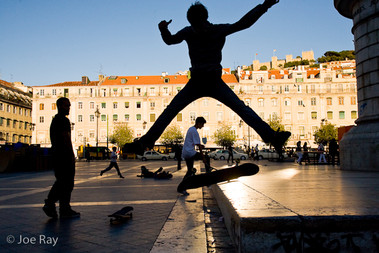 A skater takes flight in Lisbon’s central Baixa district. Photos: Joe Ray for The Boston Globe
A skater takes flight in Lisbon’s central Baixa district. Photos: Joe Ray for The Boston GlobeEurope, stretched out from East to West
And propped on her elbows, stares
From beneath her romantic hair
With Greek eyes, remembering.
Her left elbow is pulled back;
Her right forms an angle.
The first, lying flat, says Italy;
The second says England and extends
the hand that holds up her face.
She stares with a fatal, sphinxian gaze
At the West, the future of the past.
The staring face is Portugal.
Over dinner, a theme of gentle melancholy and the identity it fosters is tossed around the table, each person with a slightly different nostalgic picture of the origins of their slightly sad souls.
Later, we spill out the door to continue our discussion on the streets of the bairro Alto neighborhood - the heart of Lisbon’s night life. Starting at midnight, young and old mix in the street, often ducking into tiny bars they affectionately call chapels to buy another round. Over the course of the evening, everyone trickles downhill, making a small exception near daybreak to go back up to the “illegal bakery” on Rua da Rosa where, if the police aren’t around, you queue up for sandwiches and pastries ordered through an iron grate.
One thing that sticks out over the course of the evening’s conversations is the aside, “You’ve heard fado; we’re all about jumping out the window.”
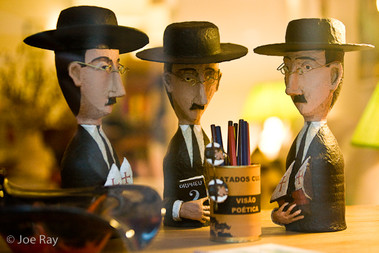 The many faces of Portuguese writer Fernando Pessoa (who wrote under many different names/personalities he called heteronyms). The cup before the figures reads “poetic vision”.Photos: Joe Ray for The Boston Globe
The many faces of Portuguese writer Fernando Pessoa (who wrote under many different names/personalities he called heteronyms). The cup before the figures reads “poetic vision”.Photos: Joe Ray for The Boston GlobeI quietly mention that I haven’t been to a fado show, and their glances urge me to rectify the situation quickly.
“Go here,” says a friend, directing me to the Mesa de Frades club in Alfama, the district where fado was born.
The next night, listening to a singer known as Carminho, people take on the look of the devout at prayer. Tinged with the deep feeling of a Berber chant or Jewish hymn, history and melancholy course through the songs.
The crowd is silent at the end of one of Carminho’s best, where the lyrics may be heartbreaking, but her voice is a vehicle for pure emotion, both singing of pain and piercing it. As a group, they shudder and capitulate and the entire city - the art, architecture, tiles on the wall, and people on the street - it all connects.
In Lisbon, there are these moments, like seeing the glint of a streetlight reflected on a tile facade, or hearing the rumble and electric hiss of a trolley, or feeling the touch of a little woman who leans on you while she’s speaking, moments where the hope and expectations of town are surpassed by reality, where, using only your heart, you understand the Portuguese love of country and the feeling about themselves that’s still being defined. It’s all there, it’s always been there: the heart on the sleeve.
Joe Ray
If you go…
Where to stay
Pensão Ninho das Ãguias
Costa do Castelo, 74
011-351-21-885-40-70
For the budget-minded, the “eagle’s nest” is hard to beat. Though the rooms are devoid of charm, the staff is kind, and there’s a terrace and a tiny sunroom accessed via a spiral staircase that offer stunning views. Doubles start at $45.
Hotel Britania
Rua Rodrigues Sampaio, 17
011-351-213-155-016 and toll-free 866-376-7831
http://www.hotel-britania.com
A four-star Art Deco gem designed by architect Cassiano Branco in 1944 and renovated in 2005. Rooms start at $175-$649.
Where to eat
O Caracol
Rua da Barroca, 14
011-351-21-342-70-94
If fresh seafood like squid or cuttlefish sautéed in their own ink doesn’t appeal, try pork that gives way under the weight of your fork. Three courses and wine for less than $39. Call ahead.
Bar do Peixe
Rua Praia do Moinho de Baixo
Near the town of Alfarim
011-351-21-684-732
Going to the Meco beach 40 minutes out of town is a perfect day trip if you’re here for a few days. The woman who runs the restaurant gets her fish from her husband, who fishes in front of the restaurant. Lunch or dinner with wine for $26-$39.
O Cacho Dourado
Rua Eca de Queriós, 5
011-351-213-543-671
If you want to dine with happy locals, this is the place. Lunch for less than $19.
Gemelli
Rua Nova da Piedade, 99
011-351-121-395-25-52
http://www.augustogemelli.com
Count on about $130 per person at this restaurant that blends Portuguese products and Italian style.
Shopping
A Vida Portuguesa
Rua Anchieta, 11
011-351-21-346-5073
http://www.avidaportuguesa.com
For hunters of unique souvenirs.
Conserveira de Lisboa
Rua dos Bacalhoeiros, 34
011-351-218-871-058
Pick up tasty canned goods and fall in love with owner Regina Ferreira.